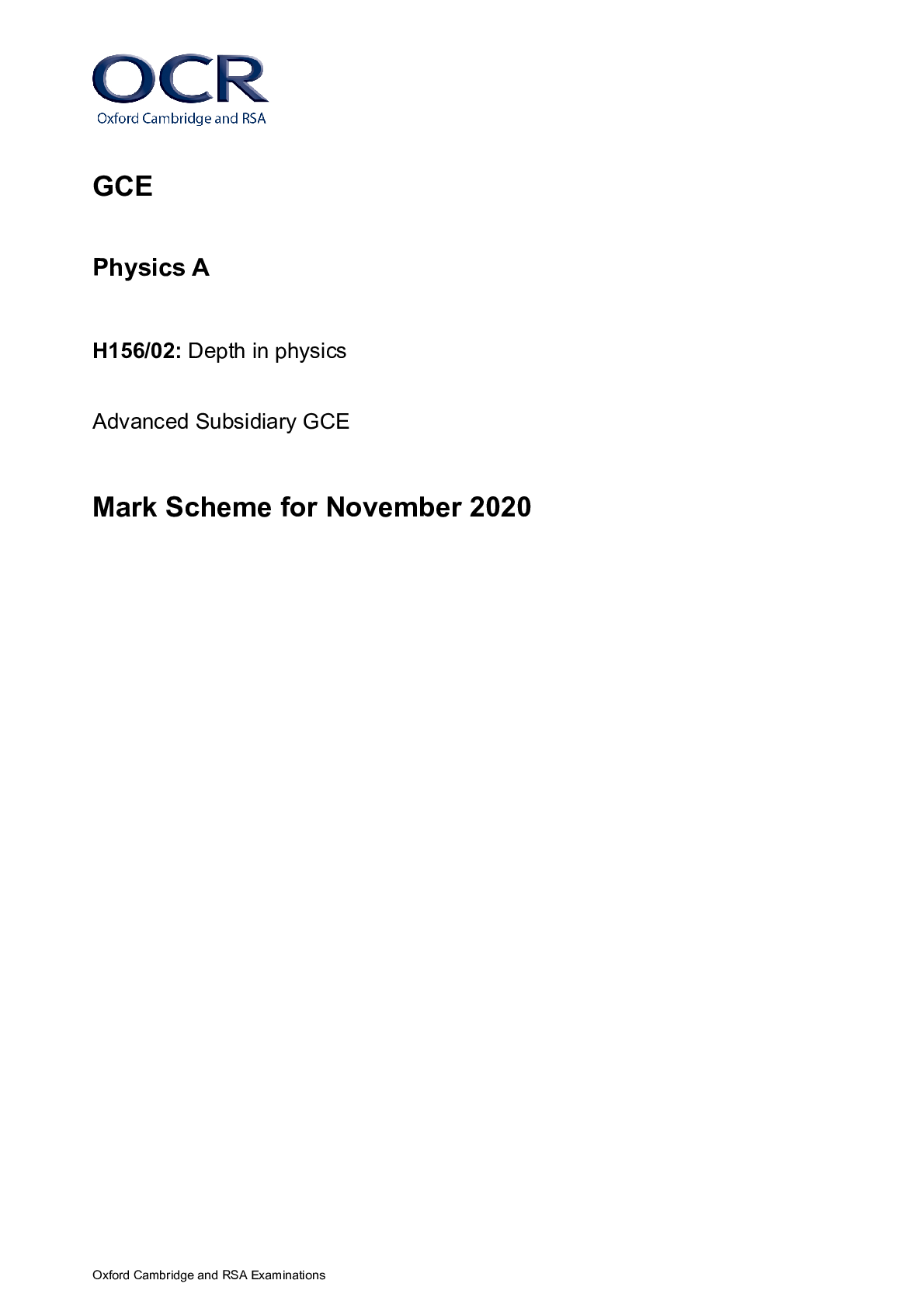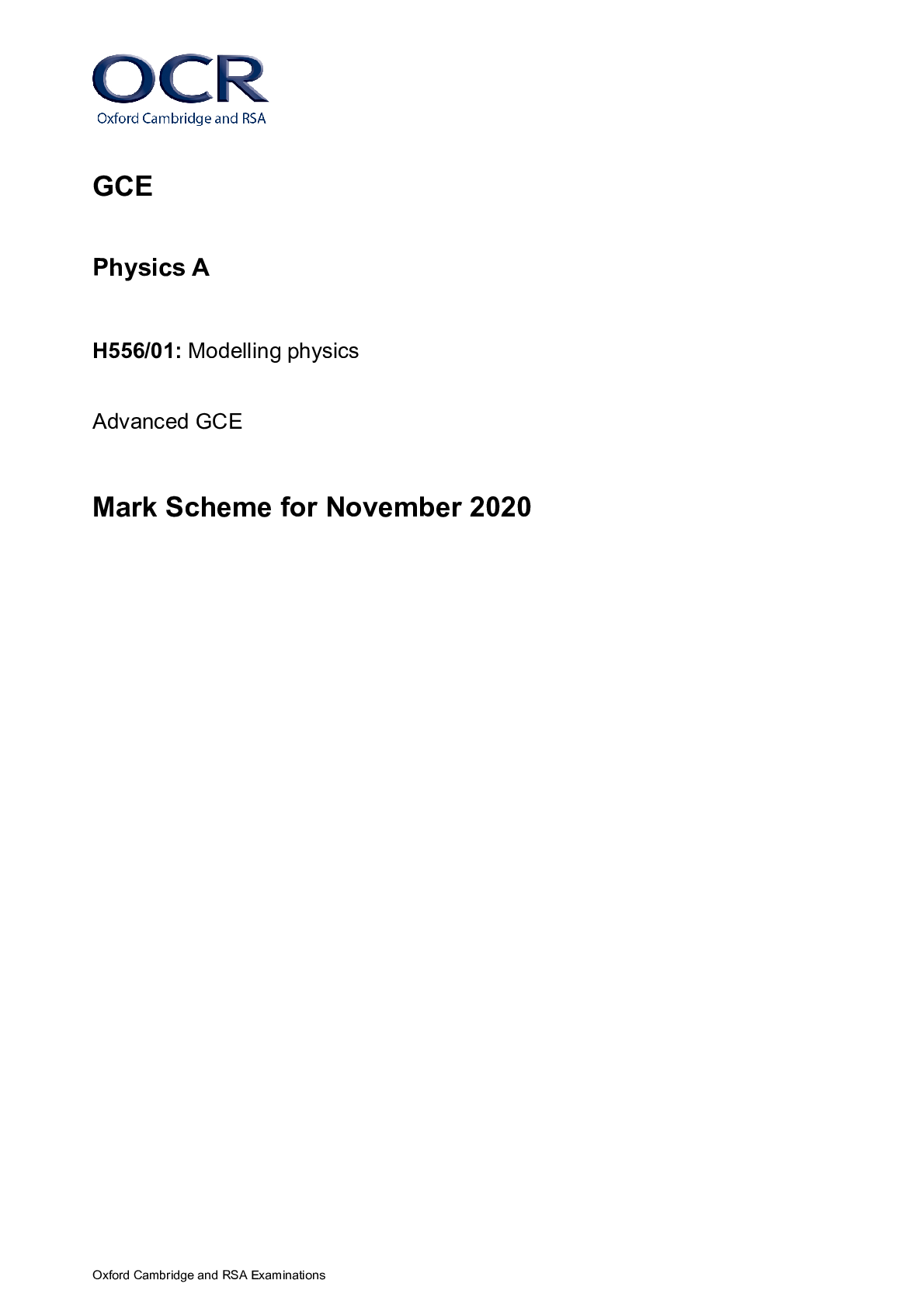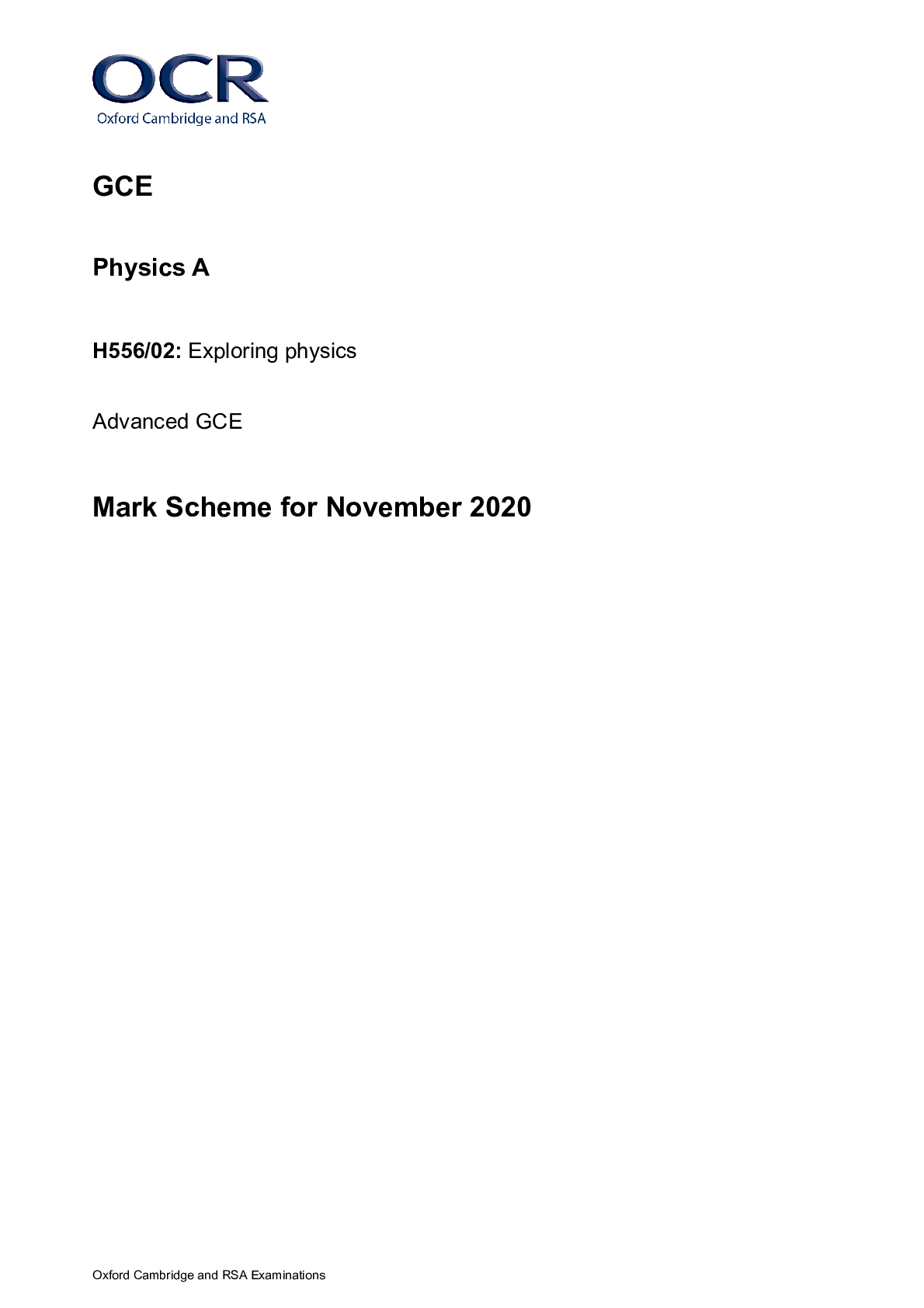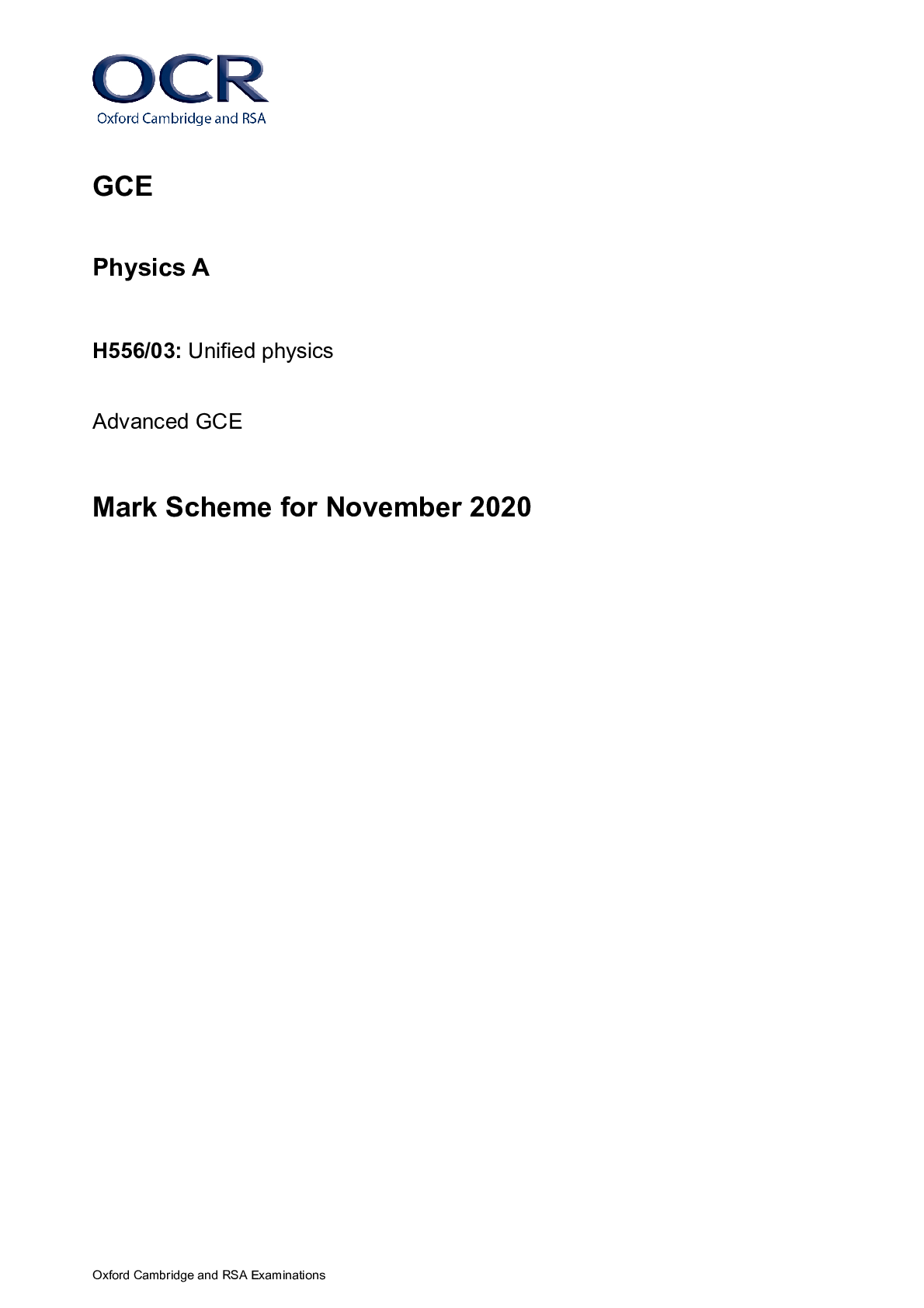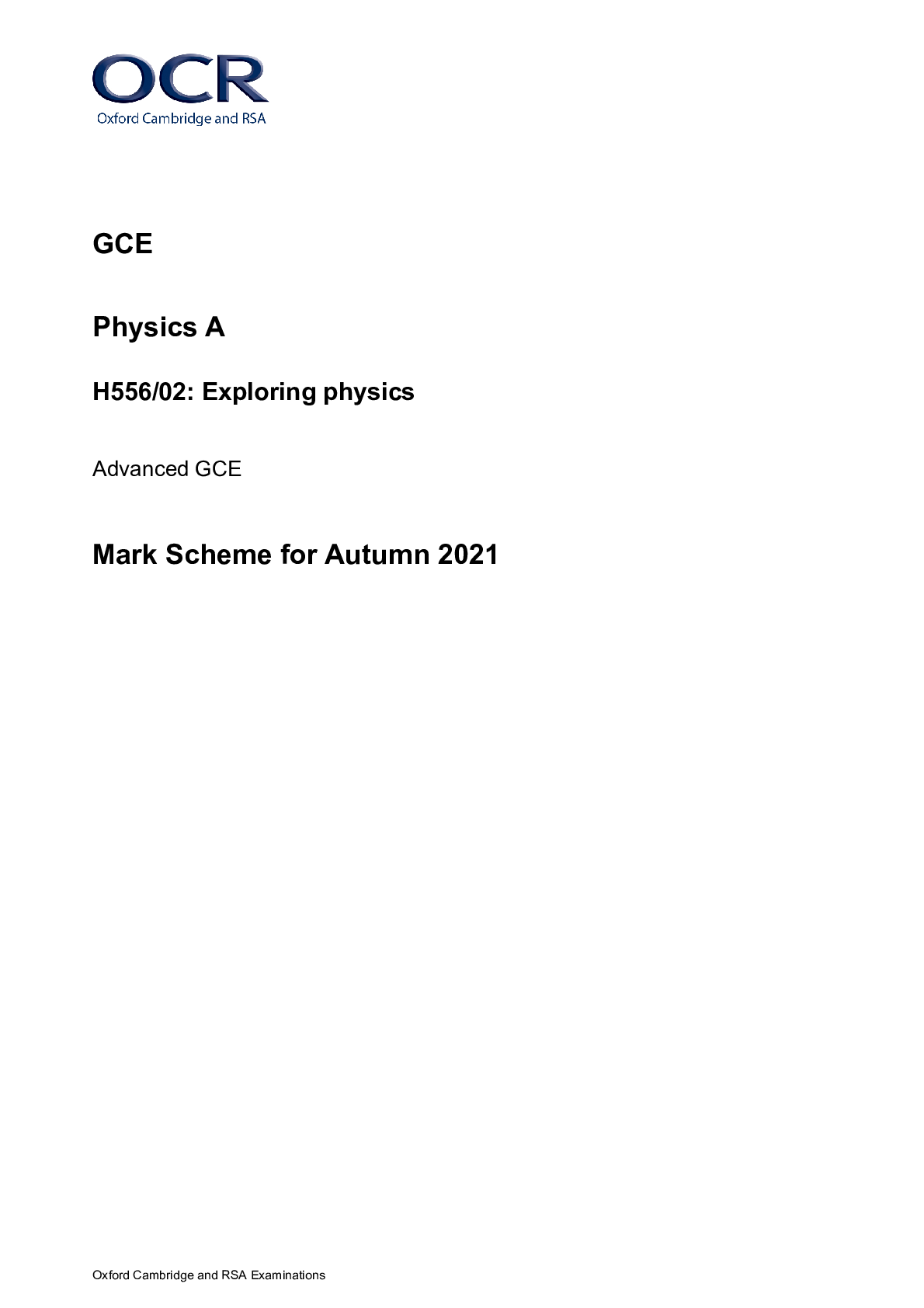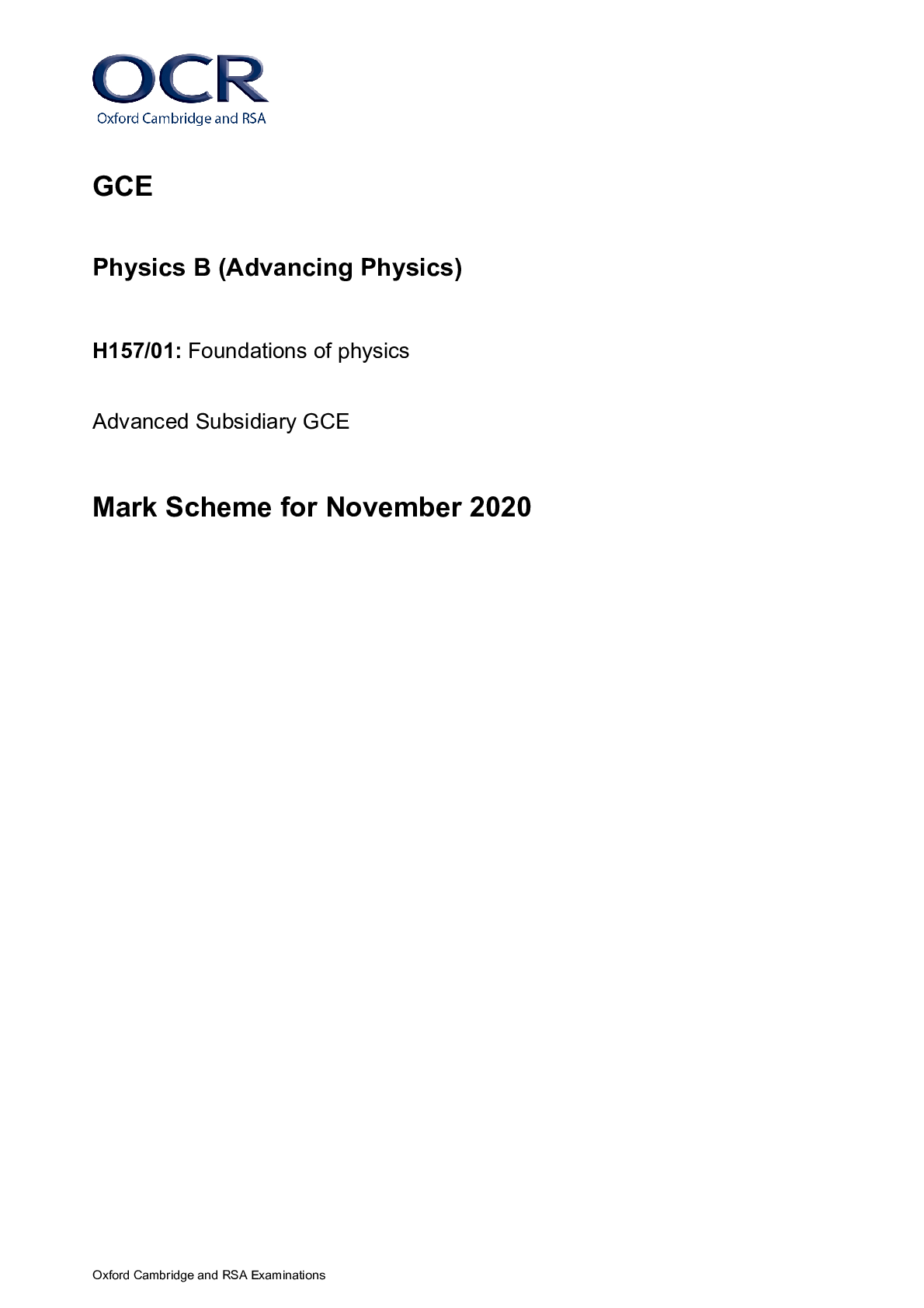Geography > AS Mark Scheme > GCE Geography H481/02: Human interactions Advanced GCE Mark Scheme for November 2020 (All)
GCE Geography H481/02: Human interactions Advanced GCE Mark Scheme for November 2020
Document Content and Description Below
Oxford Cambridge and RSA Examinations GCE Geography H481/02: Human interactions Advanced GCE Mark Scheme for November 2020Oxford Cambridge and RSA Examinations OCR (Oxford Cambridge and RSA) is ... a leading UK awarding body, providing a wide range of qualifications to meet the needs of candidates of all ages and abilities. OCR qualifications include AS/A Levels, Diplomas, GCSEs, Cambridge Nationals, Cambridge Technicals, Functional Skills, Key Skills, Entry Level qualifications, NVQs and vocational qualifications in areas such as IT, business, languages, teaching/training, administration and secretarial skills. It is also responsible for developing new specifications to meet national requirements and the needs of students and teachers. OCR is a not-for-profit organisation; any surplus made is invested back into the establishment to help towards the development of qualifications and support, which keep pace with the changing needs of today’s society. This mark scheme is published as an aid to teachers and students, to indicate the requirements of the examination. It shows the basis on which marks were awarded by examiners. It does not indicate the details of the discussions which took place at an examiners’ meeting before marking commenced. All examiners are instructed that alternative correct answers and unexpected approaches in candidates’ scripts must be given marks that fairly reflect the relevant knowledge and skills demonstrated. Mark schemes should be read in conjunction with the published question papers and the report on the examination. © OCR 2020H481/02 Mark Scheme November 2020 2 Annotations Annotation Meaning Highlight Off page comment Omission Unclear or Indicates material for which there is no credit Rubric error placed at start of response not being counted Level 1 Level 2 Level 3 Development of a point Significant amount of material which doesn’t answer the question Used to denote that points had been seen and noted but mostly where credit was given No place specific detail Highlighting an issue e.g. irrelevant paragraph. Use in conjunction with another stamp e.g. or Blank page EvaluationH481/02 Mark Scheme November 2020 3 Subject Specific Marking Instructions INTRODUCTION Your first task as an Examiner is to become thoroughly familiar with the material on which the examination depends. This material includes: • the specification, especially the assessment objectives • the question paper and its rubrics • the mark scheme. You should ensure that you have copies of these materials. You should ensure also that you are familiar with the administrative procedures related to the marking process. These are set out in the OCR booklet Instructions for Examiners. If you are examining for the first time, please read carefully Appendix 5 Introduction to Script Marking: Notes for New Examiners. Please ask for help or guidance whenever you need it. Your first point of contact is your Team Leader.H481 / 02 Mark Scheme November 2020 USING THE MARK SCHEME Please study this Mark Scheme carefully. The Mark Scheme is an integral part of the process that begins with the setting of the question paper and ends with the awarding of grades. Question papers and Mark Schemes are developed in association with each other so that issues of differentiation and positive achievement can be addressed from the very start. This Mark Scheme is a working document; it is not exhaustive; it does not provide ‘correct’ answers. The Mark Scheme can only provide ‘best guesses’ about how the question will work out, and it is subject to revision after we have looked at a wide range of scripts. The Examiners’ Standardisation Meeting will ensure that the Mark Scheme covers the range of candidates’ responses to the questions, and that all Examiners understand and apply the Mark Scheme in the same way. The Mark Scheme will be discussed and amended at the meeting, and administrative procedures will be confirmed. Co-ordination scripts will be issued at the meeting to exemplify aspects of candidates’ responses and achievements; the co-ordination scripts then become part of this Mark Scheme. Before the Standardisation Meeting, you should read and mark in pencil a number of scripts, in order to gain an impression of the range of responses and achievement that may be expected. In your marking, you will encounter valid responses which are not covered by the Mark Scheme: these responses must be credited. You will encounter answers which fall outside the ‘target range’ of Bands for the paper which you are marking. Please mark these answers according to the marking criteria. Please read carefully all the scripts in your allocation and make every effort to look positively for achievement throughout the ability range. Always be prepared to use the full range of marks.H481 / 02 Mark Scheme November 2020 5 LEVELS OF RESPONSE QUESTIONS: The indicative content indicates the expected parameters for candidates’ answers, but be prepared to recognise and credit unexpected approaches where they show relevance. Using ‘best-fit’, decide first which set of level descriptors best describes the overall quality of the answer. Once the level is located, adjust the mark concentrating on features of the answer which make it stronger or weaker following the guidelines for refinement. Highest mark: If clear evidence of all the qualities in the level descriptors is shown, the HIGHEST Mark should be awarded. Lowest mark: If the answer shows the candidate to be borderline (i.e. they have achieved all the qualities of the levels below and show limited evidence of meeting the criteria of the level in question) the LOWEST mark should be awarded. Middle mark: This mark should be used for candidates who are secure in the level. They are not ‘borderline’ but they have only achieved some of the qualities in the level descriptors. Be prepared to use the full range of marks. Do not reserve (e.g.) highest level marks ‘in case’ something turns up of a quality you have not yet seen. If an answer gives clear evidence of the qualities described in the level descriptors, reward appropriately. Quality of extended response will be assessed in questions marked with an (*). Quality of extended response is not attributed to any single assessment objective but instead is assessed against the entire response for the question.H481 / 02 Mark Scheme November 2020 6 AO1 AO2 AO3 Quality of extended response Comprehensive A wide range of detailed and accurate knowledge that demonstrates fully developed understanding that shows full relevance to the demands of the question. Precision in the use of question terminology. Knowledge and understanding shown is consistently applied to the context of the question, in order to form a: clear, developed and convincing analysis that is fully accurate. clear, developed and convincing interpretation that is fully accurate. detailed and substantiated evaluation that offers secure judgements leading to rational conclusions that are evidence based. Quantitative, qualitative and/or fieldwork skills are used in a consistently appropriate and effective way and with a high degree of competence and precision. There is a well-developed line of reasoning which is clear and logically structured. The information presented is relevant and substantiated. Thorough A range of detailed and accurate knowledge that demonstrates welldeveloped understanding that is relevant to the demands of the question. Generally precise in the use of question terminology. Knowledge and understanding shown is mainly applied to the context of the question, in order to form a: clear and developed analysis that shows accuracy. clear and developed interpretation that shows accuracy. detailed evaluation that offers generally secure judgements, with some link between rational conclusions and evidence. Quantitative, qualitative and/or fieldwork skills are used in a suitable way and with a good level of competence and precision. There is a line of reasoning presented with some structure. The information presented is in the most-part relevant and supported by some evidence.H481 / 02 Mark Scheme November 2020 7 Reasonable Some sound knowledge that demonstrates partially developed understanding that is relevant to the demands of the question. Awareness of the meaning of the terms in the question. Knowledge and understanding shown is partially applied to the context of the question, in order to form a: sound analysis that shows some accuracy. sound interpretation that shows some accuracy. sound evaluation that offers generalised judgements and conclusions, with limited use of evidence. Quantitative, qualitative and/or fieldwork skills are used in a mostly suitable way with a sound level of competence but may lack precision. The information has some relevance and is presented with limited structure. The information is supported by limited evidence. Basic Limited knowledge that is relevant to the topic or question with little or no development. Confusion and inability to deconstruct terminology as used in the question. Knowledge and understanding shows limited application to the context of the question in order to form a: simple analysis that shows limited accuracy. simple interpretation that shows limited accuracy. Un-supported evaluation that offers simple conclusions. Quantitative, qualitative and/or fieldwork skills are used inappropriately with limited competence and precision. The information is basic and communicated in an unstructured way. The information is supported by limited evidence and the relationship to the evidence may not be clear.H481 / 02 Mark Scheme November 2020 8 Question Answer Mark Guidance 1 (a) Study Fig.1, which shows percentage change of population in rural areas of England between 2001 and 2015. Use one piece of evidence from Fig.1 to show how shifting flows of people have shaped the demographic profile of rural areas in England. • 65-69 age category increased by 56% () urban-rural retirement migration (DEV) benefits of quieter rural environment / less traffic / lower cost housing / access to leisure activities (DEV) • 45-49 age category increased by 21% () urban-rural migration working at home (DEV) benefits of living in rural environment with internet access (DEV); no need to commute to work / weekly commute (DEV) • 20-24 age category increased by 19% () access to lower cost housing / safer rural environment for young families (DEV) prepared to commute to work in urban area (DEV) • 30-34 age category decreased by 17% / 35-39 by 24% () rural-urban migration, greater employment opportunities (DEV) dissatisfied by service provision / social opportunities in rural areas (DEV) 3 AO2 x2 AO3 x1 AO2 – 2 marks AO3 – 1 mark 1 x 1 () for specific evidence interpreted from the resource. 2 x 1 (DEV) for drawing conclusions from the specific resource evidence to explain how shifting flows of people have shaped the demographic profile of rural areas in England. 1 (b) Study Fig. 2, which shows cyclical economic change in the UK between 1978 and 2017. Using evidence from Fig. 2, suggest how cyclical economic change can have varied social impacts. Level 3 (6-8 marks) Application of knowledge and understanding is thorough. Analysis of the social impacts of cyclical economic change is clear, developed and accurate (AO2). 8 AO2 x4 AO3 x4 Indicative content AO2 – 4 marks Application of knowledge and understanding to analyse the social impacts of cyclical economic change could potentially include: • household income / disposable income varies in periods of boom and recession; this has varied social impacts such as access to / affordability of housing, health and education services, leisure activities, luxuries • social impacts of booms and recessions haveH481 / 02 Mark Scheme November 2020 9 Demonstrates thorough investigation of the graph to fully evidence the varied social impacts of cyclical economic change. Ideas about the social impacts of cyclical economic change are good (AO3). Level 2 (3-5 marks) Application of knowledge and understanding is reasonable. Analysis of the social impacts of cyclical economic change is sound and accurate (AO2). Demonstrates reasonable investigation of the graph to fully evidence the social impacts of cyclical economic change. Ideas about the social impacts of cyclical economic change are sound (AO3). Level 1 (1-2 marks) Application of knowledge and understanding is basic. Analysis of the social impacts of cyclical economic change is basic and accurate (AO2). Demonstrates basic investigation of the graph providing limited evidence of the social impacts of cyclical economic change. Ideas about the social impacts of cyclical economic change are limited, with limited or no link to resource evidence (AO3). 0 marks No response or no response worthy of credit. disproportionate effects on disadvantaged groups; for example, in recession low income households less able to withstand periods of unemployment / reduced income than wealthier households • social impacts of periods of economic growth, (new investment, creation of job opportunities, reduced unemployment, increased household income) include raising standards of living, lifting people out of poverty, increased household spending on housing, health, education, leisure, luxury items. • social impacts of periods of recession, (higher unemployment, reduced household / disposable income) include cuts in household spending on recreation, health, education, housing / rent; falling standard of living • strong link between unemployment and health, especially mental health, during periods of recession and afterwards • impact on government spending on social services such as differing decisions to spend on health, education, housing in periods of recession and boom • the spatial dimension of recession such as the impact of structural unemployment leading to service decline in particular areas, exacerbating social inequality geographically AO3 - 4 marks Evidence from investigation and interpretation of the graph could potentially include: Decline • periods of decline in economic growth such as 2007-09 (+3.5% falling to -5.2%) • periods of rising unemployment such as 2007- 11 (5.3%-8.2%) GrowthH481 / 02 Mark Scheme November 2020 10 • periods of economic growth such as 2009-10 (- 5.2% rising to +1.8%) • periods of falling unemployment such as 2013- 17 (7.8%-4.4%) Also, credit reference to varied duration of booms / recessions and rates of change in GDP growth / unemployment. 1 (c) Suggest two ways that time-space compression can influence our sense of place. Level 3 (5-6 marks) Demonstrates thorough knowledge and understanding of how our sense of place can be influenced by timespace compression. This will be shown by including well-developed ideas about the links between timespace compression and sense of place. Level 2 (3-4 marks) Demonstrates reasonable knowledge and understanding of how our sense of place can be influenced by time-space compression. This will be shown by including developed ideas about the links between time-space compression and sense of place. Level 1 (1-2 marks) Demonstrates basic knowledge and understanding of how our sense of place can be influenced by timespace compression. There may be simple ideas about the links between time-space compression and sense of place. 0 marks No response or no response worthy of credit. 6 AO1 x6 Indicative content AO1 – 6 marks Knowledge and understanding of ways that time-space compression can influence our sense of place could potentially include: • improved transport and communications, overcoming spatial / distance barriers, has led to global trade connections, with goods in shops in ACs sourced from across the world providing a sense of global connection on the high street; or has influenced our emotional attachment to / perceptions of place • easier flows / transfers of money / investments, through advances in e-communications, leading to creation of financial hubs in ACs such as changed sense of place in Canary Wharf from dockland to service centre; or development of outsourcing, such as changed sense of place in the industrial structure of Bangalore • flows of people and ideas across the world occur more easily, for example increased labour mobility, which has influenced sense of place by influencing the ethnic diversity in some places, changing the cultural and built environment • spread of global brands now trading on high streets, threatens uniqueness of high streets, smaller independent traders may go out of business, can affect sense of place negatively with feelings of dislocationH481 / 02 Mark Scheme November 2020 11 1 (d)* ‘Successful rebranding of a place is rarely the product of a single strategy.’ To what extent do you agree? AO1 Level 3 (6–8 marks) Demonstrates thorough knowledge and understanding of rebranding strategies. The answer should include accurate place-specific detail. Level 2 (3–5 marks) Demonstrates reasonable knowledge and understanding of rebranding strategies. The answer should include some place-specific detail which is partially accurate. Level 1 (1–2 marks) Demonstrates basic knowledge and understanding of rebranding strategies. There is an attempt to include place-specific detail but it is inaccurate. 0 marks No response or no response worthy of credit. AO2 Level 3 (6–8 marks) Application of knowledge and understanding is thorough. Analysis is clear, developed and accurate. Evaluation of the extent to which successful rebranding is the product of more than one strategy is detailed. Judgements are secure and evidence based leading to rational conclusions. Level 2 (3–5 marks) Application of knowledge and understanding is reasonable. Analysis is sound and shows some accuracy. Evaluation of the extent to which successful rebranding is the product of more than one strategy is sound. Judgements and conclusions are generalised, 16 AO1 x8 AO2 x8 Indicative content AO1 – 8 marks Knowledge and understanding of rebranding strategies could potentially include: • market-led strategies such as those of private investors taking the lead, including property developers and business owners • top-down strategies involving large scale organisations, often public sector such as local authority planning departments • flagship development such as large-scale oneoff property developments using distinctive architecture – a catalyst for further development • legacy, for example, where investment and regeneration follows major sporting event • events and themes, such as major festivals or designation as capital of culture, acting as catalyst for cultural development and further urban regeneration AO2 – 8 marks Application of knowledge and understanding to analyse and evaluate the extent to which successful rebranding is a product of more than one strategy could potentially include: • evaluation of a single strategy which can be successful in rebranding a place • evaluation of a range of strategies which can be involved / required for successful rebranding of a place • the range of strategies may depend on the scale and nature of the place designated for rebrandingH481 / 02 Mark Scheme November 2020 12 with limited use of evidence. Level 1 (1–2 marks) Application of knowledge and understanding is basic. Analysis is simple and limited in accuracy. Evaluation of the extent to which successful rebranding is the product of more than one strategy is un-supported and conclusions are simple. 0 marks No response or no response worthy of credit. Quality of extended response Level 3 There is a well-developed line of reasoning which is clear and logically structured. The information presented is relevant and substantiated. Level 2 There is a line of reasoning presented with some structure. The information presented is in the most-part relevant and supported by some evidence. Level 1 Information is basic and communicated in an unstructured way. The information is supported by limited evidence and the relationship to the evidence may not be clear. • the involvement of a range of different players / stakeholders, each with different inputs, may lead to a range of strategies which are coordinated • rebranding may take place over a period of time involving different strategies at different stages • only a single element may be needed for a successful rebranding process (architecture, heritage, retail, art, sport, food) or more than one of these elements may be required to contribute to a successful rebranding strategyH481 / 02 Mark Scheme November 2020 13 Question Answer Mark Guidance 2* ‘The greatest challenges within the global trade system are faced by LIDCs.’ Discuss. AO1 Level 3 (6–8 marks) Demonstrates thorough knowledge and understanding of challenges within the global trade system faced by LIDCs and other countries. The answer should include accurate place-specific detail. Level 2 (3–5 marks) Demonstrates reasonable knowledge and understanding of challenges within the global trade system faced by LIDCs and other countries. The answer should include some place-specific detail which is partially accurate. Level 1 (1–2 marks) Demonstrates basic knowledge and understanding of challenges within the global trade system faced by LIDCs and other countries. There is an attempt to include place-specific detail but it is inaccurate. 0 marks No response or no response worthy of credit. AO2 Level 3 (6–8 marks) Application of knowledge and understanding is thorough. Analysis is clear, developed, convincing and accurate. Evaluation of whether the greatest challenges within the global trade system are faced by LIDCs is detailed and substantiated. Judgements are secure and evidence based leading to rational conclusions. 16 AO1 x8 AO2 x8 Indicative content AO1 – 8 marks Knowledge and understanding of challenges within the global trade system faced by LIDCs and other countries, could potentially include: Challenges faced by LIDCs • limited access to global markets • removing barriers which prevent integration into global supply chains • difficulty in attracting investment • exploitation by some TNCs including land grabbing • poor infrastructure • political instability / corruption • weak position in negotiating trade agreements • severe internal inequalities (social / spatial) Challenges faced by other countries • the impacts of trade deficit; economic, socioeconomic, political • trade disputes • border / customs control • environmental impacts such as caused by port growth AO2 – 8 marks Application of knowledge and understanding to analyse and evaluate challenges within the global trade system faced by LIDCs and other countries, could potentially include: • an evaluation of the challenges faced by LIDCs as a result of their peripherality in the global trade systemH481 / 02 Mark Scheme November 2020 14 Level 2 (3–5 marks) Application of knowledge and understanding is reasonable. Analysis is clear, developed and shows accuracy. Evaluation of whether the greatest challenges within the global trade system are faced by LIDCs is detailed. Judgements are generally secure with some link between rational conclusions and evidence. Level 1 (1–2 marks) Application of knowledge and understanding is basic. Analysis is simple and shows limited accuracy. Evaluation of whether the greatest challenges within the global trade system are faced by LIDCs is un-supported and offers simple conclusions. 0 marks No response or no response worthy of credit. Quality of extended response Level 3 There is a well-developed line of reasoning which is clear and logically structured. The information presented is relevant and substantiated. Level 2 There is a line of reasoning presented with some structure. The information presented is in the most-part relevant and supported by some evidence. Level 1 Information is basic and communicated in an unstructured way. The information is supported by limited evidence and the relationship to the evidence may not be clear. • an evaluation of the challenges faced by other countries, ACs / EDCs, as a result of their strength in the global trade system • understanding that the challenges faced by LIDCs in gaining access to global markets are economic, political, social, and environmental • understanding that LIDCs have very limited influence within the global trade system whereas ACs and some EDCs have strong influence and drive global trade • understanding that the challenges presented by international trade may have short-term and longer-term impacts for the countries involved • reference to relative impact of opportunities presented within the global trade system Place-specific detail could be drawn from any LIDC, such as Sierra Leone, any AC, such as USA, and any EDC, such as India.H481 / 02 Mark Scheme November 2020 15 Question Answer Mark Guidance 3* ‘The greatest challenges within the global migration system are faced by LIDCs.’ Discuss. AO1 Level 3 (6–8 marks) Demonstrates thorough knowledge and understanding of challenges within the global migration system faced by LIDCs and other countries. The answer should include accurate place-specific detail. Level 2 (3–5 marks) Demonstrates reasonable knowledge and understanding of challenges within the global migration system faced by LIDCs and other countries. The answer should include some place-specific detail which is partially accurate. Level 1 (1–2 marks) Demonstrates basic knowledge and understanding of challenges within the global migration system faced by LIDCs and other countries. There is an attempt to include place-specific detail but it is inaccurate. 0 marks No response or no response worthy of credit. AO2 Level 3 (6–8 marks) Application of knowledge and understanding is thorough. Analysis is clear, developed and convincing and accurate. Evaluation of whether the challenges within the global migration system are faced by LIDCs is detailed and substantiated. Judgements are secure and evidence based leading to rational conclusions. 16 AO1 x8 AO2 x8 Indicative content AO1 – 8 marks Knowledge and understanding of challenges within the global migration system faced by LIDCs and other countries, could potentially include: Challenges faced by LIDCs • economic and social ‘brain drain’ effects • loss of both low-skilled and highly skilled labour • loss of young / fit / purposeful / better qualified population • exploitation of workers; problems of human trafficking, forced labour, sex exploitation • inequalities; spatial, such as internal rural-urban migration; socio-economic, such as impact of financial remittances Challenges faced by other countries • border control including people trafficking, contraband, and security • integration of immigrant groups into the host society both in terms of numbers and range of ethnic groups • supply of services where migrant groups are concentrated • coping with the issues of asylum seekers and refugees • scale of illegal immigration AO2 – 8 marks Application of knowledge and understanding to analyse and evaluate challenges within the global migration system faced by LIDCs and other countries could potentially include:H481 / 02 Mark Scheme November 2020 16 Level 2 (3–5 marks) Application of knowledge and understanding is reasonable. Analysis is clear, developed and shows accuracy. Evaluation of whether the greatest challenges within the global migration system are faced by LIDCs is detailed. Judgements are generally secure with some link between rational conclusions and evidence. Level 1 (1–2 marks) Application of knowledge and understanding is basic. Analysis is simple and shows limited accuracy. Evaluation of whether the challenges within the global migration system are faced by LIDCs is un-supported and offers simple conclusions. 0 marks No response or no response worthy of credit. Quality of extended response Level 3 There is a well-developed line of reasoning which is clear and logically structured. The information presented is relevant and substantiated. Level 2 There is a line of reasoning presented with some structure. The information presented is in the most-part relevant and supported by some evidence. Level 1 Information is basic and communicated in an unstructured way. The information is supported by limited evidence and the relationship to the evidence may not be clear. • evaluation of the significance of challenges faced by LIDCs in the global migration system • evaluation of the significance of challenges faced by ACs / EDCs in the global migration system • understanding that the challenges faced by LIDCs and other countries are economic, political, social, and environmental • understanding that LIDCs have very limited influence and restricted ability to respond to change within the global migration system whereas ACs have strong influence and drive global migration through their migration policies • understanding that the challenges presented by international migration may have short-term and longer-term impacts for the countries involved • internal urban-rural migration in LIDCs creates many challenges for both urban and rural areas such as the issue of squatter settlements and the issue of labour force • the challenges may depend on the scale, rapidity, duration and changing age / gender composition of the migrant flows • relative impact of opportunities within the global migration system Place-specific detail could be drawn from any LIDC, such as Laos, any AC, such as USA, and any EDC, such as Brazil.H481 / 02 Mark Scheme November 2020 17 Question Answer Mark Guidance 4 (a) (i) Study Fig. 3, which shows female primary school attendance rates for selected countries, 2017. Calculate the interquartile range for the data in Fig. 3. You must show your working. Upper quartile minus lower quartile = 85 - 50 () Interquartile range = 35 () 2 AO3 x2 AO3 – 2 marks 1 x 1 mark () for showing correct working-out. 1 x 1 mark () for correct answer. Credit candidate use of UQ at ¾ x (n+1) and LQ at ¼ x (n+1) (a) (ii) Give two limitations of the interquartile range in describing the spread of data in Fig.3. • only gives the spread for the middle 50% of the data / does not give information about the spread of data in the top 25% and bottom 25% of the distribution • does not show the distribution of actual values within the interquartile range • does not show the distribution of values smaller than the lower quartile / larger than the upper quartile • does not describe the degree of dispersion or give any measure of the skewness (more positive or negative) in a skewed distribution 2 AO3 x2 AO3 – 2 marks 2 x 1 mark () for giving appropriate limitations of the interquartile range in describing the spread of data for female primary school attendance in Fig.3. 4 (b) Explain how two different types of human rights violation can be a cause of conflict. Level 2 (3-5 marks) Application of knowledge and understanding is thorough. Analysis of how violation of human rights can cause conflict is sound and shows accuracy. Level 1 (1-2 marks) Application of knowledge and understanding is basic. Analysis of how violation of human rights can cause conflict is simple and there is limited accuracy. 5 AO2 x5 AO2 – 5 marks Application of knowledge and understanding to analyse how violation of human rights can cause conflict could potentially include: • denial of basic human needs, such as food and shelter; caused by corrupt / inadequate / discriminatory government • denial of access to education / health care; caused by insufficient government planning / investment / legislationH481 / 02 Mark Scheme November 2020 18 0 marks No response or no response worthy of credit. • discrimination / unjust denial of freedom, such as female exclusion from decision-making in unrepresentative / undemocratic governments • lack of respect for ethnic identity / right to practise own religion, can lead to genocide / torture, for example in instances of human rights violations exacerbated by further violence • domestic violence towards women / discrimination in the work place, such as in patriarchal societies 4 (c) With reference to a case study of one country, explain the strategies used to address gender inequality issues. Level 3 (6–8 marks) Demonstrates thorough knowledge and understanding of strategies used to address gender inequality issues. This will be shown by including well-developed explanations. The answer should include accurate place-specific detail. Level 2 (3–5 marks) Demonstrates reasonable knowledge and understanding of strategies used to address gender inequality issues. This will be shown by including developed explanations. The answer should include some place-specific detail which is partially accurate. Level 1 (1–2 marks) Demonstrates basic knowledge and understanding of strategies used to address gender inequality. This will be shown by including simple explanations. There is an attempt to include place-specific detail but it is inaccurate. 0 marks No response or no response worthy of credit. 8 AO1 x8 Indicative content AO1 – 8 marks Knowledge and understanding of strategies used to address gender inequality issues could potentially include: • ratification / signing of treaties and conventions • increasing number of national and state laws • intervention for example in the work of various NGOs • increasing adherence of MNCs to their Corporate Social Responsibilities • strengthening rule of law via strengthened state apparatus • improving female enrolment in education Reference to a case study must be included; there is no requirement for a candidate to make reference to more than one case study. There are many possible examples at all levels of development; India is just one country where much attention is being given to this issue.H481 / 02 Mark Scheme November 2020 19 Question Answer Mark Guidance 5 (a) (i) Study Fig. 4, which shows the number of personnel deployed in selected UN Peacekeeping operations, 2018. Calculate the interquartile range for the data in Fig. 4. You must show your working. Upper quartile minus lower quartile = 15,450 – 1,020() Interquartile range = 14,430 () 2 AO3 x2 AO3 – 2 marks 1 x 1 mark () for showing correct working-out. 1 x 1 mark () for correct answer. Credit candidate use of UQ at ¾ x (n+1) and LQ at ¼ x (n+1) (a) (ii) Give two limitations of the interquartile range in describing the spread of data in Fig.4. • only gives the spread for the middle 50% of the data / does not give information about the spread of data in the top 25% and bottom 25% of the distribution • does not show the distribution of actual values within the interquartile range • does not show the distribution of values smaller than the lower quartile / larger than the upper quartile • does not describe the degree of dispersion or give any measure of the skewness (more positive or negative) in a skewed distribution 2 AO3 x2 AO3 – 2 marks 2 x 1 mark () for giving appropriate limitations of the interquartile range in describing the spread of data for personal deployed in UN Peacekeeping operations in Fig.4. 5 (b) Explain how two different types of threat to territorial integrity can be a cause of conflict. Level 2 (3-5 marks) Application of knowledge and understanding is thorough. Analysis of how threats to territorial integrity can cause conflict is sound and shows accuracy. Level 1 (1-2 marks) Application of knowledge and understanding is basic. Analysis of how threats to territorial integrity can cause conflict is simple and there is limited accuracy. 5 AO2 x5 AO2 – 5 marks Application of knowledge and understanding to analyse how threats to territorial integrity can be a cause of conflict could potentially include: • separatism / claims for secession, people seeking independence or autonomy may be marginalised or suppressed by a state government leading to demonstrations / violence / terrorism • contested territory where control over land,H481 / 02 Mark Scheme November 2020 20 0 marks No response or no response worthy of credit. people and borders is disputed, such as the annexation of Crimea or conflict over contested islands in the South China Sea of strategic importance • competition for exploitation of the same or scarce resource, such as contested maritime boundaries which are disputed over oil and gas resources, or the conflict over Kashmir for water supply • ethnic partition where arbitrary political boundaries established in the past, such as the legacy of colonialism in Africa, has led to conflict • government inability to control contested areas as a result of inadequate state apparatus, such as police and military, has led to conflict between authorities and terrorists / traffickers / smugglers, such as in Mali 5 (c) With reference to a case study of one country, explain how challenges to its sovereignty can have impacts on people. Level 3 (6–8 marks) Demonstrates thorough knowledge and understanding of factors that explain how challenges to sovereignty can have impacts on people. This will be shown by including well-developed explanations. The answer should include accurate place-specific detail. Level 2 (3–5 marks) Demonstrates reasonable knowledge and understanding of factors that explain how challenges to sovereignty can have impacts on people. This will be shown by including developed explanations. The answer should include some place-specific detail which is partially accurate. 8 AO1 x8 Indicative content AO1 – 8 marks Knowledge and understanding of factors that explain how challenges to sovereignty can have impacts on people could potentially include: • death and injury to civilians during demonstrations, rioting and military conflict • damage to people’s homes and property in cases of armed conflict • restricted access to services such as health care / medicines, food and education during any conflict • disruption of livelihood • population displacement, refugees and IDPs • negative impacts of some TNCs where there is exploitation of resources and workers • famine, for example during periods of civil warH481 / 02 Mark Scheme November 2020 21 Level 1 (1–2 marks) Demonstrates basic knowledge and understanding of factors that explain how challenges to sovereignty can have impacts on people. This will be shown by including simple explanations. There is an attempt to include place-specific detail but it is inaccurate. 0 marks No response or no response worthy of credit. Reference to a case study must be included; there is no requirement for a candidate to make reference to more than one case study. Possible examples could include, Ukraine, South Sudan, Mali, Afghanistan.OCR (Oxford Cambridge and RSA Examinations) The Triangle Building Shaftesbury Road Cambridge CB2 8EA [Show More]
Last updated: 1 year ago
Preview 1 out of 23 pages
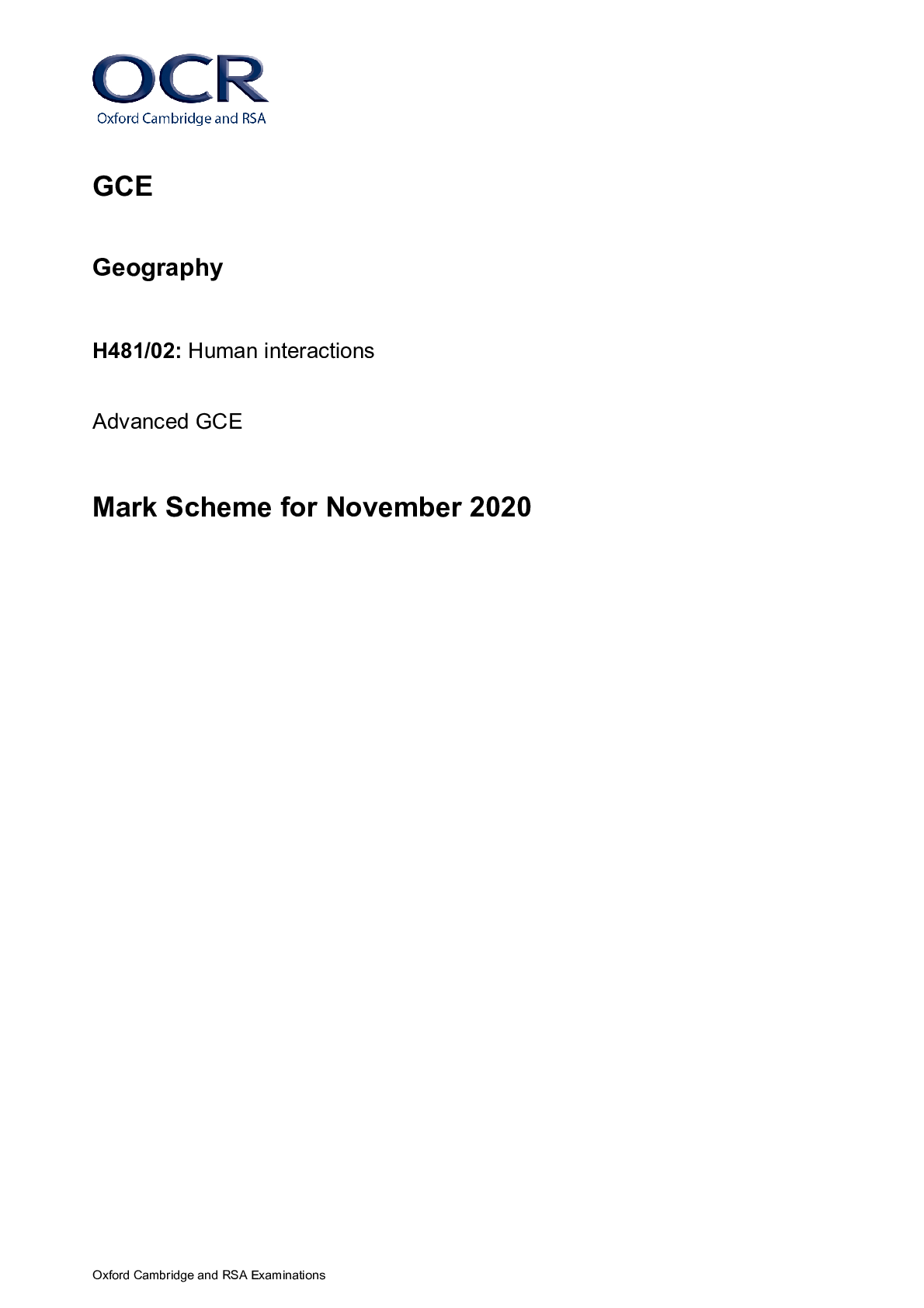
Buy this document to get the full access instantly
Instant Download Access after purchase
Add to cartInstant download
We Accept:

Reviews( 0 )
$7.50
Document information
Connected school, study & course
About the document
Uploaded On
Oct 10, 2022
Number of pages
23
Written in
Additional information
This document has been written for:
Uploaded
Oct 10, 2022
Downloads
0
Views
67

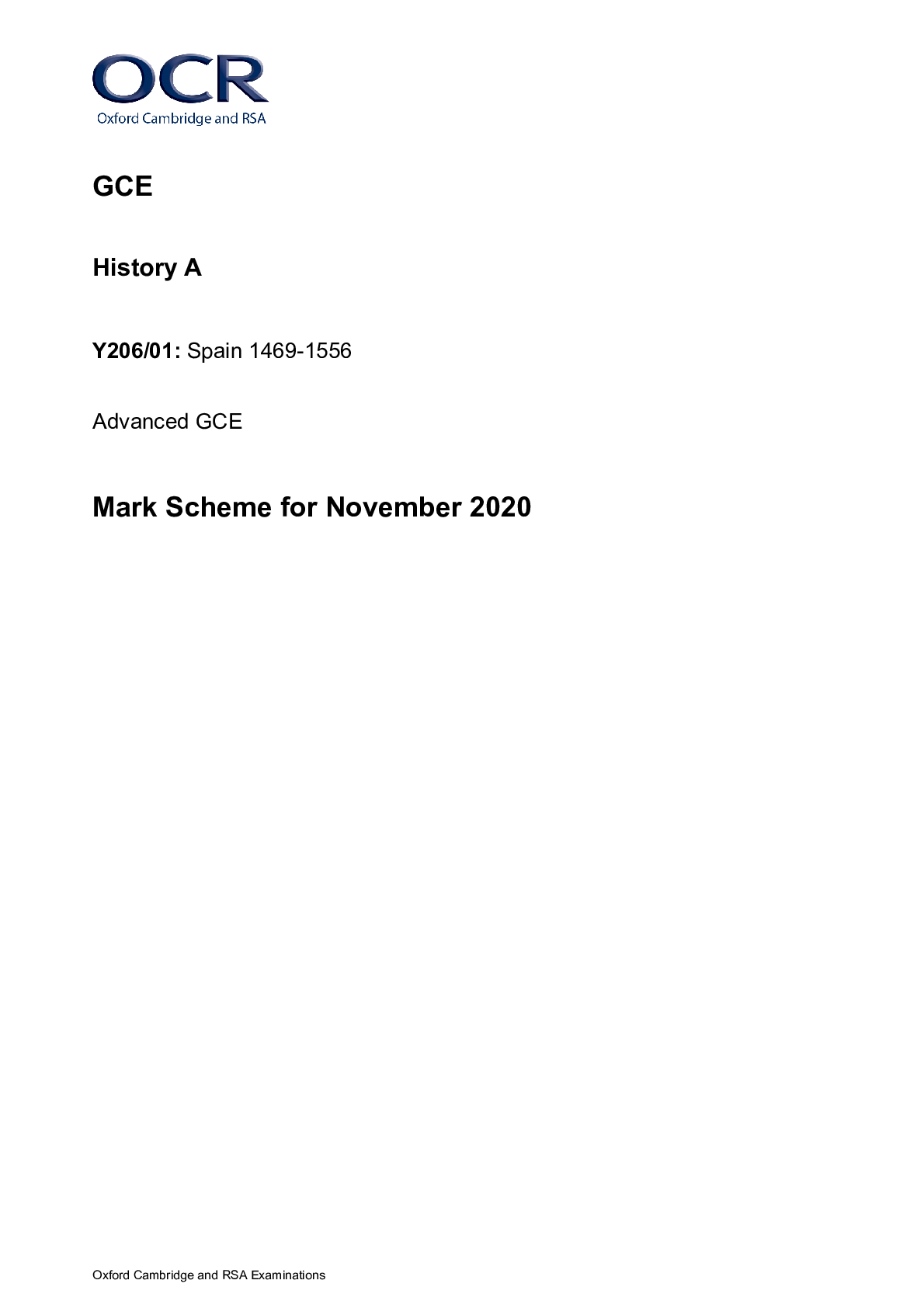
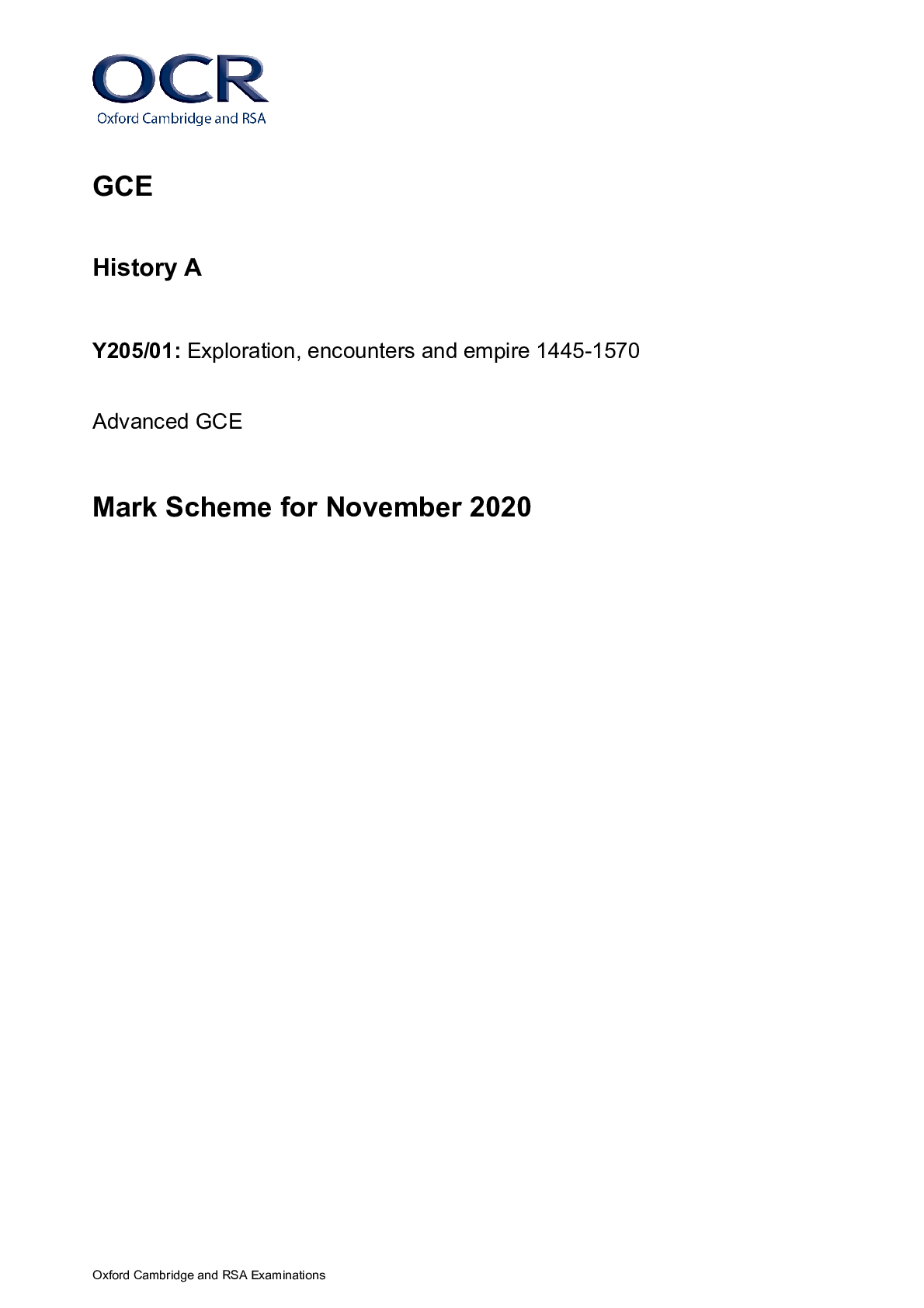






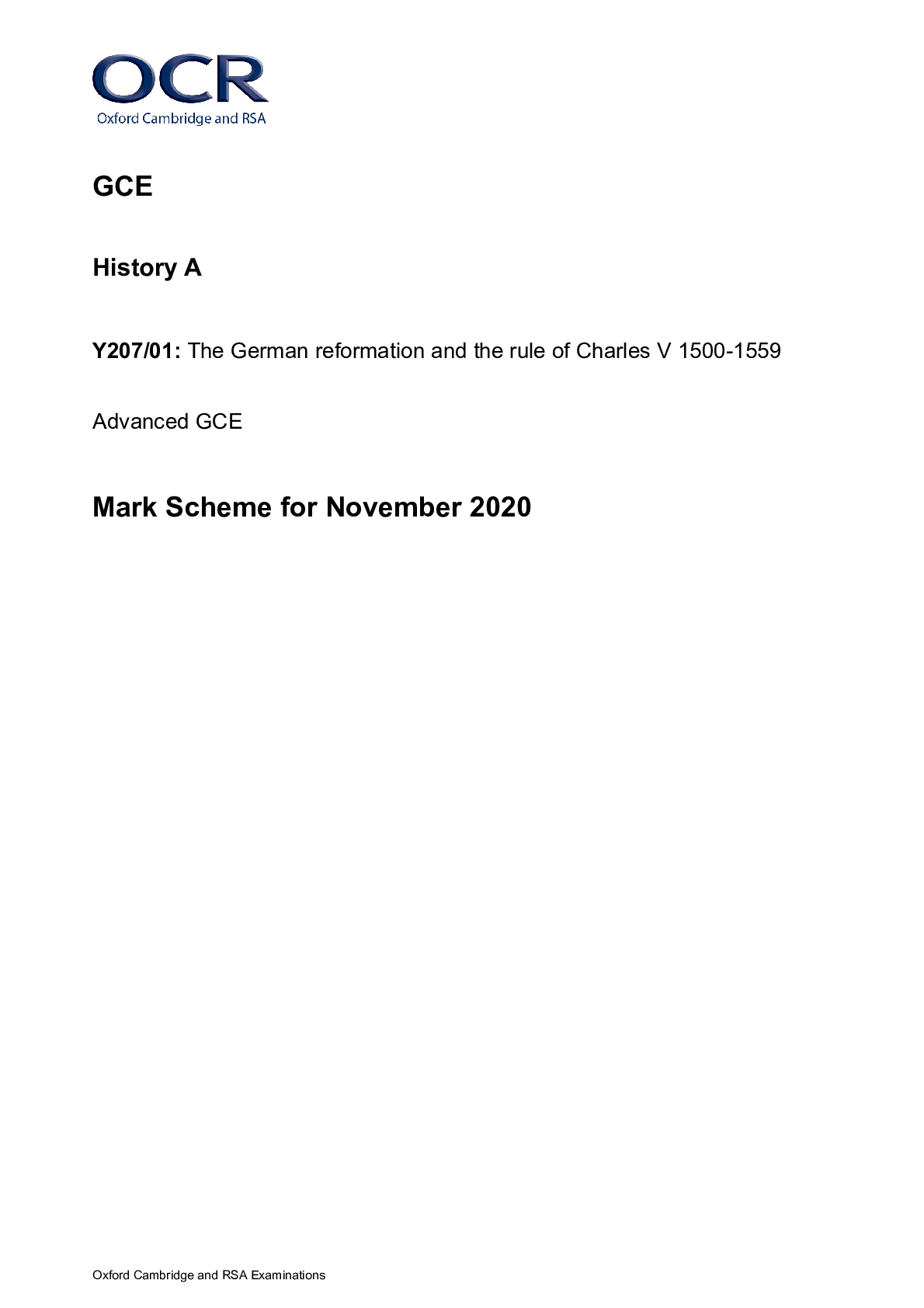





.png)

